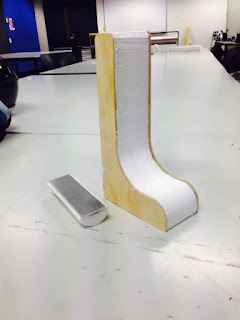PROBLEM SOLVING
Week 10 presentation
(Problems found)
1) During the presentation the red light stopped glowing
(issues with RGB LED LIGHT)
&
and the light intensity was too weak
2) The servo motor wasn't able to rotate the wing
(weak rotation power)
3) The model base wasn't stable
4) Friction between Top cover and wing
(motor couldn't rotate the wings due to the Friction between top cover and wing)
due to the curved wing, as it rotates it lift up the top cover
5) aesthetic of the the product wasn't appealing
(First concept design)
(received feed back from peers "doesn't look like a lamp... looks like a wooden block")
(Improving Design)
Aesthetic
Experiment with using shoe wax to create wooden texture
Half of the shell with wooden texture
(planning stage)
Testing
(Improving Design)
Functionality
(silicon rubber feet - self adhesive)
attached on the model to test out the stability
Friction testing (stability)
(Improving Design)
Old structure design
New structure design
specially designed to reduce the friction between wing and structure
&
also added in the fillet to increase the stiffness / rigid-ability
Model making
(new design)
Reprinting the new parts
(3D printing the shell cover)
(Assembling)
assembling reprinted parts
assembly Testing
(Painting)
painting shoe wax on the parts with paint brush
After adding shoe wax on to the 3d printed parts, the sticky tape was removed to create clear separation line on the shell cover (half wood texture / half white plastic)
Fully Functional model
3D Degital model
(Hero shot)
NEW Design

OLD Design
1) Aesthetic has been improved
2) Remade the structure + gears in side the model has been remade to reduce the friction
3) Designed to be easily customized
Video Making
(Planning stage)
group decided to make a funny video to draw attention to the audience
(fun and more engaging)
Presentation board
Final Presentation Video
(new design)
Reprinting the new parts
(3D printing the shell cover)
(Assembling)
assembly Testing
over view of the final model
(Painting)
painting shoe wax on the parts with paint brush
After shoe wax is all dried it was been coated with nail polisher to have glossy finish
(Functionality Test)
Added led light inside to visualize the lighting quality
Fully Functional model
3D Degital model
(Hero shot)
NEW Design

OLD Design
1) Aesthetic has been improved
2) Remade the structure + gears in side the model has been remade to reduce the friction
3) Designed to be easily customized
Video Making
(Planning stage)
group decided to make a funny video to draw attention to the audience
(fun and more engaging)
Presentation board
Final Presentation Video














































